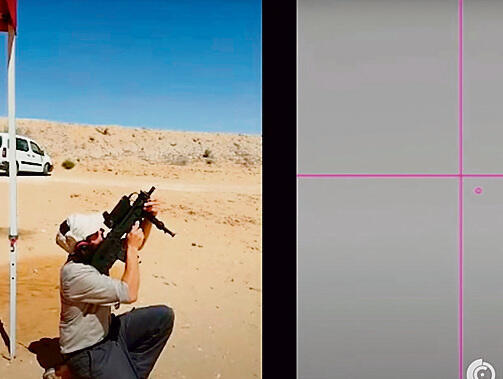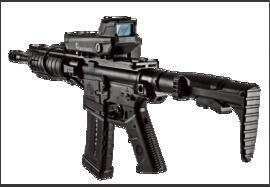The phone of Michal Mor, founder and CEO of Smart Shooter, who is sitting in front of me, does not stop receiving congratulatory messages, even from abroad. The reason: on the day we met, it was announced that Israeli forces in Gaza managed to eliminate a swarm of seven attack drones using the SMASH smart fire control system, developed by the company.
More stories:
And this was not the first time. SMASH proved to be particularly effective against drones in the war in the Gaza Strip, and against Hamas terrorists in face-to-face combat. The system, which has already been purchased by the IDF and other armies around the world, is now being used for the first time in wartime - and with great success. Professional military websites - including the IDF's official website – describe it as groundbreaking.
5 View gallery
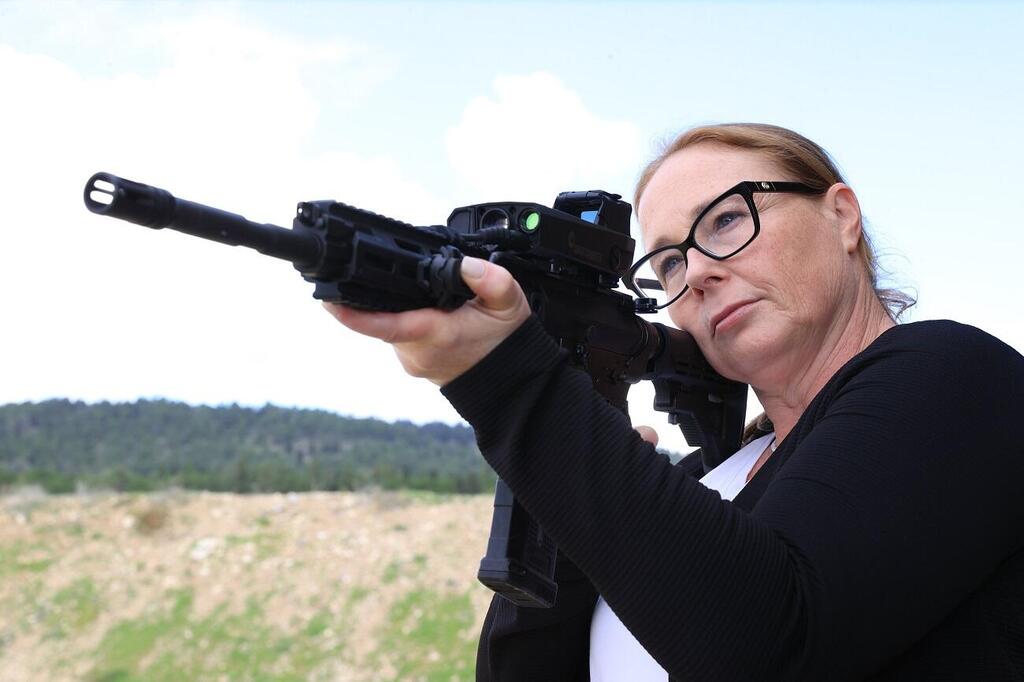

Smart Shooter CEO Michal Mor with the SMASH smart fire control system
(Photo: Elad Gershgorn)
Mor previously worked as a team leader for R&D groups in the missile division of Israel’s arms manufacturer Rafael Advanced Defense Systems Ltd. Then, following her husband's military reserve service in the Second Lebanon War, she came up with the idea that changed her life and sent her on a new path.
"In 2006, I was nine months pregnant, my husband who served in the Golani Infantry Brigade, got a call-up order and entered Lebanon equipped with a standard low-tech weapon. When I looked at the rifle, at the steel, I realized that I had the ability to dramatically improve the sight," she says.
"Until the use of SMASH, the rifle was nothing more than metal. So, we incorporated into the rifle the technology used for missile interception, which I'm familiar with. The goal is to allow soldiers, certainly reservists who do not train regularly, to hit the target precisely at the first shot. During combat, a reservist does not have time to re-gain operational capabilities."
The technology ensures precise hit of moving targets, regardless of the soldier's level of training, including hit of drones - the new threat on the battlefield since the Ukraine war and now in Gaza and in the north against Hezbollah.
Through advanced artificial intelligence-based image processing, SMASH locks on the target and tracks its movement to synchronize the shot release for a swift and precise hit. The SMASH is much more than an optical scope - it's a sophisticated fire control system. The system detects, among other things, the direction and speed of the target's movement. If the barrel is not aimed exactly at the target, the trigger will not be pulled and the fighter, who follows the target through a screen, will encounter a small block.
5 View gallery
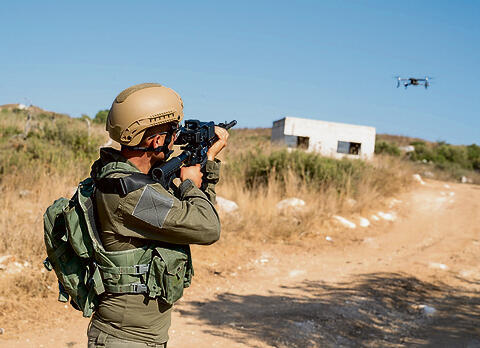

The SMASH smart fire control system used against a drone
(Photo: Courtesy of Smart Shooter)
Beyond the incredible accuracy, the system can track and hit from a longer range of 200 meters (650 feet), compared to about 50 meters (165 feet) with a rifle with a normal sight, which adds to the safety of the shooter.
"I came from the world of missiles, where the goal is to minimize their use and make them surgical, with the motto being 'minimum fire, maximum hit'," says Mor. "Armies today, prioritize the safety of their forces and ensuring that innocent civilians remain unharmed.
"A soldier in battle is facing a complicated challenge being under physical and mental pressure, and I wanted to ensure that he could accurately hit the target while keeping him safe not only from a range of 50 meters but also when he hits from 200 meters. Think how hard it is for a soldier, while running, to hit a dynamic target - a terrorist that's running, a vehicle that is breaking through a barrier.
"I read a NATO study that examined the probability of a hit among soldiers worldwide and concluded that the figures are not high, because both the soldier and the target are moving during battle. Our system provides ballistic calculations to reach maximum hit. In the tests we conducted, we proved that the level of accuracy when using our technology was the same for recruits and for experienced soldiers."
The IDF were skeptical
Smart Shooter has already signed purchase agreements with the U.S., mainly for the use of the Marines, with the Netherlands, India and Germany. Last July, it was announced that the British army had purchased 225 systems for 4.6 million pounds, which will be installed on assault rifles and will also be used by special forces aiming to hit drones.
According to reports, the company is also involved in projects with the manufacturer Roboteam to integrate the system on an autonomous combat robot, and with manufacturer Steadicopter to be used for drones.
Today, in all IDF infantry units there is a rifleman equipped with the SMASH system, which costs several thousand shekels, and now in the Gaza war, it has come into use by reservists as well. The IDF has uploaded a video on its official website praising the SMASH, stating that it quadruples the forces’ chances of hitting their target, and thousands of it have already been used by the soldiers in the Gaza Strip. The proven success in wartime has increased the demand for the system worldwide.
The IDF says that it plans to increase the sight’s distribution in the near future, train more reservists to use it, improve its night operational capabilities and develop an option for soldiers to be able to identify friendly forces in order to avoid blue-on-blue incidents, which unfortunately occurs frequently in densely populated urban warfare in Gaza.
Mor, 49, married and a mother of 2, residing in Haifa, has an MSc in Industrial Psychology and Human Factors Engineering from the Technion. "In the army, I served as a diagnostician and I continued to study psychology," Mor says.
"I did my graduate degree in psychology at the Technion. My thesis paper was about 'attention control when switching between tasks.' I checked how well people can switch between tasks in a complex environment, and under what conditions. I imagined the pilot's cockpit, which had to be operated using hundreds of switches and instruments. As part of my studies, I instructed engineers from Rafael who were doing a graduate degree at the Technion, and they offered me a job at Rafael as a team manager. In 1999, I joined the company.
"At Rafael, I worked as a manager of R&D teams - at first in the field I was familiar with, Human Factors Engineering, and later in the field of guided missiles. I learned a lot about system characterization, user needs, systems engineering. Rafael is a Zionist technological manufacturer whose goal is to provide the IDF with cutting-edge technology and deterrent power. I adopted its fine DNA. I worked there for seven years, and in 2006 I left together with a member of my team, Avshalom Ehrlich, a software engineer who is now my partner, and we drifted into the field of startups.
"At Rafael, after all, you're a cog in a machine. Albeit essential, but still a cog. We moved to work in a small technology company, where I could also engage in marketing, liaising with investors, etc. In 2008, the global hi-tech crisis broke out, we left the company and decided to establish our own startup. Avshalom is the innovator among us, and I listen to his ideas, trying to figure out what will work, and make it happen. I'm the CEO and he's the CTO."
There are not many women in your field. How did the IDF react when you first introduced the SMASH?
"The first meeting took place at the Ministry of Defense - Directorate of Defense Research & Development (IMOD DDR&D) and we brought along only a prototype: a laptop connected to Airsoft (a type of air rifle not intended for combat), which took us three years to develop, in order to present our innovative technology. We said, 'We have a great idea'. And their response was, 'It will never work'. The army is a conservative institution, the perception until then was that personal weapons were a traditional thing - low-tech, without algorithms. It was only later when we explained it to the missile people at the DDR&D, they understood the potential, and after conducting tests that proved its effectiveness, they were convinced.
"In Golani, who were the first at the time to use the system, they told us at first: 'Don't touch our weapons,' because as soon as you activate the system, it is the system which decides when to shoot, not you. Later, they were convinced that the system knows how to accurately hit the target, whether you are a regular soldier, a novice or a reservist who has not touched a weapon for a long time. The system gets power from a battery that lasts for 72 hours, and the soldier is equipped with a spare battery (some say that the use of a battery is a weak point of the system, although Mor claims that two batteries are enough for four days of combat in a row).
"In Golani, who were the first at the time to use the system, they told us at first: 'Don't touch our weapons,' because as soon as you activate the system, it is the system which decides when to shoot, not you. Later, they were convinced that the system knows how to accurately hit the target, whether you are a regular soldier, a novice or a reservist who has not touched a weapon for a long time."
"I'm sure that at first, it was strange for army officials to see a woman presenting the system. There aren't many women in the industry. There aren't any female CEOs in Israel's renowned defense industries. When I go to conferences or exhibitions abroad, it is very easy for me to find my name tag, because most of the participants are men. To the credit of the Ministry of Defense, when I first came to the largest military exhibition in the U.S. in 2018, the ministry asked me – and not Rafael or the Aerospace Industry - to deliver the opening speech at the Israeli Pavilion. I said there: 'I thank the Ministry of Defense for supporting a big vision with a small record, and thanks to the big industries that paved the way for us."
How do you combine motherhood with your career?
"I have two teenagers, Arielle, 17, and Yoav, 14, who grew up in and with the company. I am a very involved mother; it was a condition I set for myself. The biggest compliment I received was when my daughter started school, and parents asked me what my profession was. When I told them, they were surprised and said they were sure I was unemployed, because I was always involved in the parents' committee, never missing the children's events in kindergarten and at school.
"I remember myself in Lag BaOmer (a Jewish holiday) attending my daughter's bonfire, from there flying to the U.S., and returning to attend my son's bonfire. I consider it a compliment that my daughter, when asked what she wants to be when she grows up, answers: I will replace mom in the job.
"The combination of being a wife, mother, entrepreneur in the high-tech world and CEO of a defense company is not trivial, but I find that all these parts together have made me more focused and precise. Apart from not having a personal acquaintance from my military days with colleagues, like the men in my field have with their colleagues, I find that being a woman in the field is an advantage. If there were more women in the military industry and in the field, the definition of the goals and the way to achieve them would have looked different.
5 View gallery
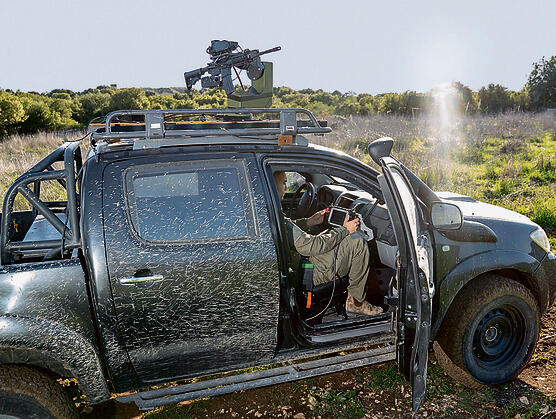

Smart Shooter's remote-controlled fire control system
(Photo: Courtesy of Smart Shooter)
"When we marked one month since the attack on October 7, my daughter, who is a troop counselor in the Scouts, asked me to give a lecture to the senior class about the war. She asked me to speak directly to the point. I thought of ways to bring it up, making the information accessible. I talked about the threats we encountered in the war, such as the tunnels, the drones, and explained what solutions the defense industry can provide, as well as our solution for drones. When I asked at the end what they had learned, they said they were happy that there was someone who understands the threat and solves it. I felt that it calmed them down."
How does SMASH deal with the drone threat?
"Drones can be used to drop munition on the troops or to observe them. These are two significant threats. Each armed drone can cause a two-digit number of casualties even when it hits from the sky. That's why we improved the hit capability of SMASH so that it is also effective at a range of 200 to 300 meters above the soldiers. If we shoot down a drone when it's 300 meters away from the soldier, it's dramatic.
"By the way, before the Gaza war, the SMASH was also used to take down the incendiary balloons that set Israeli fields surrounding the Gaza Strip on fire. They would say to me, 'But there are still fires', and I answered: But we prevented 20 others. The ability to handle drones In Gaza became operational, and now in the war, I realized that we need to receive information about the drone threat and its location from a greater distance than what we have today. We have a family of products designed for that purpose. Our goal is always to keep the soldier as far away from danger as possible.
"We have developed a remote-controlled system that can be operated by a soldier sitting with a tablet in a situation room, and the system, which can be mounted on a tripod, a robot or an airborne vehicle, transmits information about the target, and allows the soldier to fire at it from a distance."
It is used also to disperse demonstrations
This is an all-time record period for the defense companies in Israel. The war in Ukraine and now the war in Gaza - entailed a sharp jump in demand for Israeli developments. 2023 is considered the best year in Israel's history in terms of export of Israeli weapon systems.
The IDF says that it plans to increase the sight’s distribution in the near future, train more reservists to use it, improve its night operational capabilities and develop an option for soldiers to be able to identify friendly forces in order to avoid blue-on-blue incidents
At the forefront are the three largest Israeli companies: IAI, Rafael and Elbit. But they are not alone. Two of the best-performing companies on the Tel Aviv Stock Exchange this year come from the defense world. NextVision, which develops cameras for drones and UAVs jumped by 284%. Aryt Industries Ltd, which manufactures electronic fuses for ammunition artillery, jumped by 233%.
More than two years ago, Smart Shooter set out to raise capital from investors, and both the Phoenix insurance company and the Altshuler Shaham investment house entered into a partnership with the company. This was Phoenix's first investment in the defense field. According to an estimate, Phoenix invested about $10 million, at a company value of $100 million. Presumably, Phoenix also realized that in a world that is only getting more armed, if Mor's vision is materialized and its SMASH sight becomes a standard in the world's armies - the sky is the limit.
The company, based in Kibbutz Yagur, has 80 employees, a manufacturing plant and three marketing subsidiaries - in the U.S., Australia and Germany. It is no longer a startup company but rather a well-established self-sustaining company, and according to Mor, it will not need additional capital raising soon.
The war was "good" for the company, as it was for other defense industries, which are now experiencing peaks in orders from all over the world. Mor reports a significant growth in orders from the IDF, an increase that obliged the plant to work 24/7.
"This is the finest hour of the defense industries that provide solutions so that we can live here," she says. "This is part of the reality of our lives. Our goal is to increase the safety of the soldiers and reduce injury to innocent bystanders. Minimal fire with maximum effectiveness. During the war, we received messages from soldiers or parents asking us for the SMASH sight. Most exciting for me was to receive requests from soldiers who are children of my friends, because this whole idea was born when they were still in elementary school."
What is the vision for the future?
"The ultimate goal is to make our technology a standard on every rifle in all armies, and to continue developing features for non-combat purposes as well, such as dispersing demonstrations; when you don't want to kill but deter, the system will know how to hit, for example, only below knee. We are in the stages of developing anti-drone systems that know how to 'communicate' with other systems and activate them while transmitting information about a drone or an approaching threat directly to the sight and eliminating it through connection to other factors in the environment.
"When we will see stability in revenues and continuous growth, we intend to list it on Nasdaq, because the global market is huge. In the meantime, we have stable institutional investors, and we will not do things rashly. We live off our income. Elbit was also once a small company. It would also be nice to be purchased for a billion dollars, I always keep an eye on the capital market. My greatest achievement is establishing a company from scratch, creating it, defining it, breathing life into it and seeing that the technology enables to keep the soldiers on the battlefield safe."
I came, I shot, I hit
Elad Gershgorn
There are very few opportunities in life where one can go through experiences that look almost like science fiction. This week I experienced such a moment when I was assigned to photograph Michal Mor, CEO and founder of Smart Shooter, and was allowed to test the company's SMASH system. It happened without prior planning, at the same shooting club where I shot a few days earlier with a regular rifle that I received from the police as a member of the standby alert squad in my community, without the SMASH system of course. And what a difference that was.
Three minutes of a simple instruction given by Omer Levin, the manager of the company's operational team, and immediately after - shooting at body targets from a distance of 200 meters, with 100% success. In general, the operation is very simple: you press with your thumb on a button located on the left side of the weapon. As soon as a target is detected, the system locks on the target, and all you do is pull the trigger, and the system fires with absolute precision and hits time and time again.
I deliberately shot while standing and not in a kneeling position; there is also no need to hold your breath, and it is recommended to keep both eyes open on the system's screen - the opposite of everything I learned in the army. The screen is large and clear, the target is detected immediately, and the system tracks it independently, making it impossible to miss. The best way to describe the experience is like going from driving a horse-drawn carriage to driving a Tesla.
In my military service I was using a Galil short automatic rifle; today I am a member of the standby alert squad in my community. I've shot quite a bit in my life, but I'm not a trained marksman. Hitting targets from a range of 200 meters at a rapid rate of fire just doesn't make sense to me. It's more like playing Fortnite, but in real life. Omer explained to me that during the tests carried out on the system it was proven that beyond its ability to hit drones accurately and selectively, it can also hit ground-to-sea, water-to-sea and air-to-sea fire with insane success rates. It's like an Iron Dome installed on a personal weapon.
It just makes me think, as a member of the standby alert squad, how much this SMASH sight could help in a future scenario of invasion of Israel like the October 7 attack.



